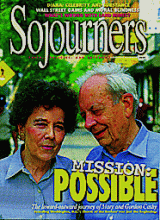When Herod saw that he had been tricked by the wise men, he was infuriated, and he sent and killed all the children in and around Bethlehem who were two years old or under, according to the time that he had learned from the wise men. Then was fulfilled what had been spoken through the prophet Jeremiah:
"A voice was heard in Ramah,
wailing and loud lamentation,
Rachel weeping for her children;
she refused to be consoled,
because they are no more."
One million children. Gone in a flash. Engulfed in the flames of Holocaust ovens by decree of a modern-day Herod. The scale of the tragedy and the weight of the horror are hard to comprehend. A walk through the Children's Memorial at the Holocaust Museum in Jerusalem offers a poignant glimpse.
I always think of children around Christmas. I conjure images of their exuberant singing of carols; the glow of their smiles in candlelight; and, yes, the wonder and delight I've seen on their faces on Christmas morning when they discover the bounty that appeared mysteriously overnight.
I try to imagine the joy that Mary felt, gazing at the face of her young son, Jesus. But the passage above from the second chapter of the gospel of Matthew always intrudes. How could she celebrate the birth of her child, knowing that other children had lost their lives because of him?
THIS YEAR my Christmas images come with more vivid detail. I have been to Bethlehem, to the "Shepherds' Field" and the Church of the Nativity. The church contains the tombs of 25 children. Children slaughtered in Herod's massacre perhaps? History doesn't tell us.
These young ones are teachers of resilience and delight. Their light is drawn from the one Light that was sent as one of them into the world 2,000 years ago. It is our responsibility to make the world better for them. Like the countless mirrors in the Children's Memorial in Jerusalem, we can reflect the Light and surround them with a sphere of hope.
Read the Full Article
